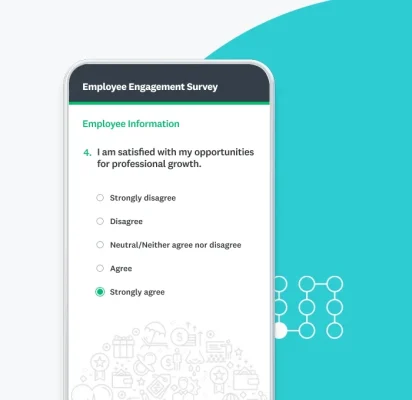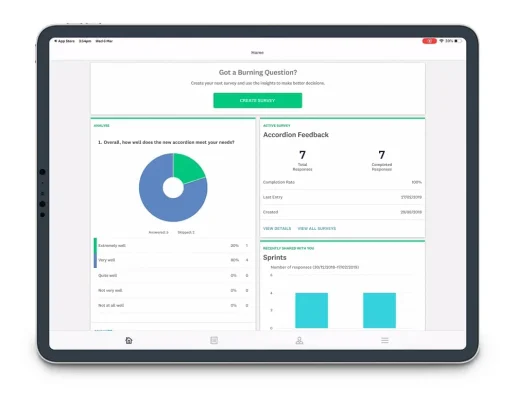How and why to create mobile-centric surveys
Design surveys tailored for mobile devices to boost response rates and capture real-time feedback.

If you lift your eyes from your phone screen for a second, you might notice that almost everyone else is looking at their phones a lot of the time: an American adult spends as much as three hours per day on their phone. Here at SurveyMonkey, we’ve seen the number of mobile responses constantly increase, with the ratio already surpassing a third among U.S. respondents.
To help reach more types of respondents and ensure high completion rates, we’ll show you how to create and design surveys on the go with templates, tips and best practices. And we’ll also see how the SurveyMonkey mobile app for iPad, iPhone and Android can help you gather and analyse this crucial feedback.
Start creating your own mobile-centric surveys today. Our app allows you to monitor results live and take full advantage of our powerful analytic capabilities. Download the SurveyMonkey Android and iOS app→
What is a mobile-centric survey?
A mobile-centric survey differs from other surveys in that it’s specifically designed to fit a smartphone or tablet screen and makes it easy for the respondent to use touchscreen gestures to answer the questions.
A few key features of a good mobile-centric survey:
- The text is larger.
- The answer options are easy to click on using your fingers.
- There are no big logos taking up most of the screen space.
- There is a fullscreen mode to avoid distractions from other apps.


- The interface for creating your surveys is intuitive and easy to handle on a touch screen. (Watch this video to see how our Android app makes survey creation a quick and simple process.)
As you can see, there are a few criteria you need to take into account when creating and designing a mobile-centric survey. We’ll go over them in more detail below.
But first, let’s align on the top reasons why you should be ready to create your own mobile-centric surveys.
Why you should use mobile-centric surveys
Mobile-centric survey questionnaires meet your audience on the go as they visit your shop/store or restaurant, walk through your event exhibition stand or wait in your business’s reception area. They can be deployed either on a screen that you provide or on the customer’s own tablet or phone.
Here are some of their benefits:
- Customer satisfaction on the spot. Hand your customers your mobile device and invite them to comment on their experience just before they leave your establishment.
- Following up. If they decline to fill the in-store survey, give them an easy way (a short link, for example) to answer it later on their smartphone.
- Higher response rates. Your survey response rates improve if you can deliver your questionnaire directly at the point of your audience’s experience or interaction.
- Multiply your impact. Extend the reach of your survey by asking your contacts to post, tweet and share it on their social and professional networks.
- Faster rewards. When you meet your users in person, you can easily award an incentive to encourage them to complete your survey.
- Heightened customer engagement. You can use mobile polling to add fun to your customers’ experience. Is your breakfast spot renowned for its pancakes? Which toppings do your customers like best?
- Real-time feedback. Is your CEO delivering a provocative speech at an event? Are you launching a cool new product? Poll the audience to quickly get a sense of how the talking points are resonating and use that feedback to plan follow-up messaging.
10 great tips on how to design a mobile-centric survey
Do you want to know how to create great mobile-centric surveys? As we said before, there are a few criteria that you need to bear in mind. The following is a compilation of great tips from our blog posts about mobile optimisation for surveys and how to increase mobile survey completion rates.
- Choose multiple choice. This question type is your friend. If possible, try to avoid matrix, open-ended and image question types , which don’t work very well on mobile browsers.
- If you really must use a matrix question… write it concisely and use no more than five response options.
- Limit the number of open-ended questions. Typing in an answer can be time consuming and lead to mistakes on smaller mobile screens.
- Be cautious when adding images and videos. Long loading times could frustrate your respondents.
- Keep it short. Surveys on the go should be a quick exercise.
- Split up your questions over successive screens. Avoid forcing users to scroll down in search of the next question.
- Use a small logo or no logo. Screen space is very valuable here, so it’s best not to squander it.
- Avoid progress bars. The same principle stated in the previous tip applies. Use precious screen space for displaying key information.
- Test your survey on the small screen. Make sure you go through the full mobile experience before your respondents do so you can detect any design glitches before going live.
- Choose the best time to launch. Surveys are more successful on weekdays, but mobile users are more likely to take them on weekends and during rush hour.
Samples of mobile-centric surveys
When you’re ready to create and deliver your mobile-centric poll or survey, you can use any one of our extended library of survey templates as is or customise it to suit your own purposes.
Alternatively, you can go straight to our Question Bank of methodologist-certified questions to build your own 100% customised mobile-centric survey.
Here are a few sample survey templates that you could use for all sorts of projects.
Market research: Conduct on-premises research by delivering surveys on mobile devices, and gather audience feedback as you evaluate the market for potential new products and services.
Customer satisfaction: How do your customers feel about your products and services or their experiences with your customer service representatives? Reach them by using surveys delivered on your in-store tablet or their mobile devices.
Online polls: Create an online poll that your target audience can access on their mobile devices and get their instant views on any relevant topic.
Before you launch your mobile-centric survey, here’s one more SurveyMonkey tool for you to take advantage of. Get the handy checklist ‘How to optimise your surveys for mobile devices’. Download now →
Learn more about best practices for surveys on the go
As with anything survey-related, SurveyMonkey has plenty of resources to help you learn more about mobile-centric surveys. When you’re ready explore the finer points of this topic in more depth, you can start by checking out our help section article for best practices in mobile survey design.
And now that you’ve finished reading this, you can lift your eyes from your phone screen for a second… and start creating your own mobile-friendly survey to get the quickest feedback from today’s hyper-connected consumers.
Discover more resources

Toolkits Directory
Discover our toolkits, designed to help you leverage feedback in your role or industry.

Continuing healthcare checklist: what UK healthcare providers need
Learn what information healthcare and social workers need to provide for a continuing healthcare checklist, what happens next and possible outcomes.

Turning employee engagement statistics into actionable surveys
Discover how to use UK employee engagement statistics to design effective surveys. Use actionable insights to boost retention and drive productivity.

Shaping the future: how British values in the workplace drive inclusion and engagement
Discover how ‘British values in the workplace’ surveys can reveal what matters most to employees, fostering inclusion and engagement.